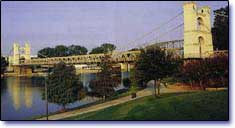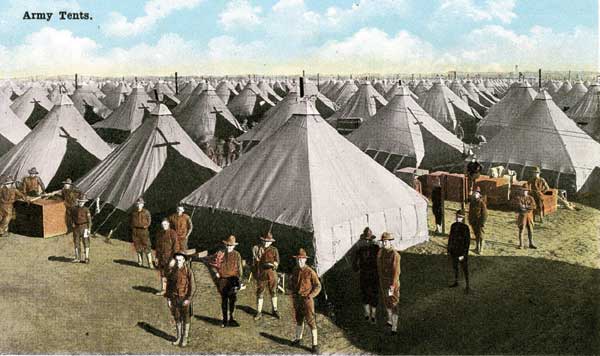

Places in Time

From ‘ Tent City’ to Camp MacArthur nation
By Terri Jo Ryan, Waco Tribune-Herald
May 29, 2006
Sgt. John Ross of Kentuckytown, Texas, would delight in telling his children in his later years about the best birthday of his life — Nov. 11, 1918.
That's the day the guns finally fell silent in Europe, which later came to be known as Armistice Day, at the end of what was then known as the "Great War."
Ross, who served in the U.S. Army's 12th Cavalry Battalion, Company D, was stationed at Camp MacArthur in Waco for most of the war. He turned 29 the day peace was declared.
"Dad said the camp went wild when the news came that the war was over," said Evelyn Kirk of Waco, one of the sergeant's seven children. "Trucks were used to transport the soldiers to the Cotton Palace Coliseum to join thousands of others who were celebrating. Dad told us he'd never had such a big birthday party in all his life as that one."
Ross had been spared the trip overseas with his comrades in arms because the flu and pneumonia kept him from being deployed. Like many a young soldier in World War I, he'd been infected when the Spanish influenza epidemic arrived in the United States.
Ross was discharged in December 1918, and he returned to the family farm. He married Irene Duniven in 1921, and had seven children. Two of their daughters — Evelyn Kirk and Wynona Troup — now live in Waco. Ross died on Oct. 2, 1967, in Abilene at age 78.
"Dad told us of crossing the Brazos River on the old extension bridge on the journey to camp," Kirk said. "Actually, the night they arrived, the tollgate on the bridge had already closed for the night, so all those soldiers had to camp out on the river bank overnight and wait for the morning to cross over."
Camp MacArthur also was the "home away from home" for serviceman Ben Eide of Belmond, Iowa. Eide was the grandfather of Debbie Duhrkopf of Woodway.
She has souvenirs of his Army days, thanks in part to a set of penny postcards of Waco the 23-year-old doughboy sent to his sister, Ellen, in Story City, Iowa, in May 1918. Stamps, by the way, only cost 2 cents each.
"The postcards have always been special to me," said Duhrkopf. "I thought it was neat that Grandpa was stationed in Waco, then years later we end up moving to Waco from Iowa."
Eide drove a horse-drawn ambulance during World War I. He also hauled supplies for Company F of the 7th Ammunition Train while serving in France.
He died Oct. 9, 1970, at age 75 in Marshalltown, Iowa, Duhrkopf said.
Construction on Camp MacArthur, a World War I training camp named for Gen. Arthur MacArthur, began on July 20, 1917. Construction costs for the installation on the northwestern side of Waco were estimated at $5 million. In September of that year, some 18,000 troops arrived from Michigan and Wisconsin to begin their drills.
The "tent city" site and military buildings covered 1,377 acres, although the entire reservation encompassed almost 10,700 acres. Facilities there included a base hospital, administrative offices and the tent camp, supplemented by 1,284 buildings.
The camp served as an infantry replacement and training camp, an officers' training school and eventually as a facility for disbanding military units, disposing of their equipment and returning the men to civilian life.
Some of the site is the sprawling grounds of the red-brick Waco Center for Youth is today 3501 N. 19th.
The 32nd "Red Arrow" Division, which saw combat in France in 1918, was among the Waco-trained units.
At war's end, the camp was ordered salvaged on Jan. 3, 1919, and materials from it were used to construct border stations on the United States-Mexican border. The camp was officially closed on March 7, 1919, and the grounds became part of the city of Waco.
One of the lasting legacies of Camp MacArthur was its effect on the nightlife of its host city: The red light district called "The Reservation," where prostitution was legally recognized, licensed, and regulated by the city starting in 1889, was closed in 1917. Encouraged by the U.S. Army's attempts to eliminate temptations for the soldiers, the city's ministers and others waged a campaign against the bawdy houses, and the brothels were closed.
For
more information, contact: John Young • Waco
Tribune-Herald •